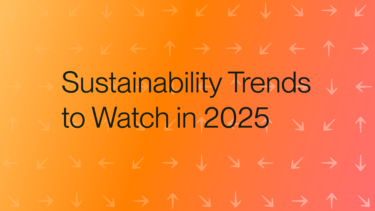
Contents
- Latest SBTi criteria
- What's changed?
- The revalidation process
- Revalidation deadline
- Meeting or missing targets
- Setting new near-term targets
- Making a net-zero commitment
- How Anthesis can help
- Contact us
Share this article
Within the past five years, many companies set near-term emissions reduction targets in-line with the Science Based Targets Initiative (SBTi). Their targets are a first step, setting and publishing an ambition to meaningfully decarbonise their business operations at the pace and scale required to align with the Paris Agreement. Now many of these companies must review and revalidate their targets with SBTi to align with their latest criteria and evolution in climate science.
Curtis Harnanan and Jonno Oon explore what has happened since those original targets were set and provide guidance on how businesses can successfully revalidate their next SBTs.
What does the latest SBTi criteria say about revalidation?
Since some initial targets were set, the SBTi has updated its criteria to ensure targets remain ambitious and aligned with the latest climate science. Organisations that set SBTs five years ago must revalidate these targets to ensure they are still on a credible path to limiting global warming the ambitions established in the Paris Agreement, aiming to limit global warming to 1.5°C in line with the latest climate science.
The revalidation process involves a comprehensive review of the companies’ existing targets against the updated SBTi general criteria and any relevant new or revised sector-specific criteria. This includes assessing the scope, boundary, and ambition levels of each target and the progress made toward achieving these existing targets.
What’s changed in the last 5 years?
Several key changes have taken place in the SBT landscape over the past five years:
- Ambition Levels: The SBTi has shifted its focus from a dual pathway (2.0°C and 1.5°C) to prioritising the more ambitious 1.5°C target. Companies are now encouraged to set targets that align with the 1.5°C trajectory to ensure a more significant impact on mitigating climate change.
- Sector-Specific Guidance: The SBTi has developed new sector-specific guidance to provide more tailored approaches for industries. Financial Institutions and companies which fall into the apparel, aviation, ICT, steel, power and cement sectors, amongst others, will find that new, sector-specific guidance has been created for them that considered the unique challenges and opportunities within their sector.
- FLAG Targets: In 2022, the SBTi released sector-specific guidance for the forestry, land and agriculture (FLAG) sectors, offering a method to create separate Science-Based Targets (SBT) that include land-related emissions and removals. Many companies with FLAG-related emissions will be required to set and validate FLAG targets if they have not yet done so.
- Net-zero Standard: First released in 2021, the Corporate Net-Zero Standard sets the process and criteria for committing to setting a long-term target to reach net zero. Revalidation offers a key milestone for organisations to review their targets and potentially increase ambition in line with setting these longer-term targets. A revision of the corporate net-zero standard is currently underway, with public consultation expected to commence in Q4 2024.
- SME Definitions: The SBTi updated the definition of an SME in November 2023, directing more companies to use the standard target setting route. While companies that had set targets under the previous SME definition, any organisations that now wish to resubmit or recalculate their targets will need to meet the new definition requirements, which can be found here. If not, they will need to begin using the standard target setting route, which may imply a new scope 3 target.
These changes mean that organisations may need to adjust their existing targets to meet the higher ambition levels and sector-specific requirements. This ensures that their targets remain scientifically robust and credible.
The revalidation process
Anthesis’ approach to revalidating SBTs involves several key steps:
- Re-engage stakeholders: Identify and inform stakeholders who were previously involved in setting the targets. Ensure any new stakeholders are onboarded and engaged around the existence and need for a Science-Based Target.
- Review of existing target: Ensure that the current target is aligned with the latest criteria and guidance from the SBTi, for both near-term and net-zero targets, if relevant.
- Review progress against the target: Study how you have performed against the target, engage stakeholders to understand how decarbonisation efforts are progressing and what could be accelerated, if possible.
- Recalculate the target: Extend any emissions forecasts to the new target horizon (if relevant) or refresh the assumptions that underpin the forecasts. Model the target pathways for Scope 1 & 2 (1.5°C) and Scope 3 (1.5°C and well-below 2°C). This may, pending other findings, involve updating the ambition or timeframe of the target.
- Engage stakeholders: Inform key stakeholders on the updated targets and ensure all parties are aligned on the new targets once again.
- Submit and validate the revised targets: Complete the latest SBTi target submission forms and work with the SBTi through re-validation of the new target.

Revalidation deadline and consequences
The SBTi requires companies to revalidate their targets every five years. Failure to do so can result in the expiration of the targets and the target being labelled as “Commitment Removed”, potentially undermining the credibility of a company’s climate commitments. This could impact stakeholder trust and result in reputational risks.
Implications of meeting or missing near-term targets
As companies approach the end of their current target timeframe, they need to evaluate their performance:
- Met Targets: If a company has met or exceeded its near-term targets, it demonstrates strong climate leadership and can build on this success by setting even more ambitious near and long-term targets.
- Missed Targets: If a company has not met its targets, it should identify the reasons for the shortfall and develop a corrective action plan. The business should report progress towards these targets in its annual public reporting (e.g., within ESG report, CDP disclosure, etc.) and should be transparent about the corrective actions and how these (with appropriate governance) are going to help achieve the revised/revalidated targets. Implementing strategic, short-term action plans as well as longer-term roadmaps will support target achievement success.
Setting new near-term targets
Near-term targets are crucial for driving immediate action and demonstrating progress. As such, organisations need to continuously set and pursue near-term targets, regardless of whether they are making a net zero commitment. These new near-term targets must continue to be aligned with the ambition and decarbonisation trajectory in the latest corporate near-term target standard. The only exception to this requirement is when a net-zero commitment is nearing its end. In this situation, companies are not expected to set an additional near-term target.
Making a net zero commitment
Committing to net-zero emissions is becoming increasingly important for businesses, and the target revalidation point is a great time to consider, if not already established, a net-zero target. A net-zero target demonstrates a company’s commitment to eliminating its carbon footprint and contributing to global climate goals, decouples carbon and climate-related impacts from its ability to operate and grow and assures future business resiliency by mitigating business-specific risk and broader societal/climatic impacts.

How Anthesis can help
Revalidating SBTs and setting longer-term net zero targets can be complex and resource intensive. Anthesis offers comprehensive support to organisations throughout the revalidation process and throughout their net zero journey.
Partnering with Anthesis ensures that your organisation’s SBTs remain credible, ambitious, and aligned with the latest climate science, mitigating your climate risk and ensuring your business’ future relevancy and resiliency in a net zero economy.
Get in touch
We are the world’s leading purpose driven, digitally enabled, science-based activator. And always welcome inquiries and partnerships to drive positive change together.
We’d love to hear from you





